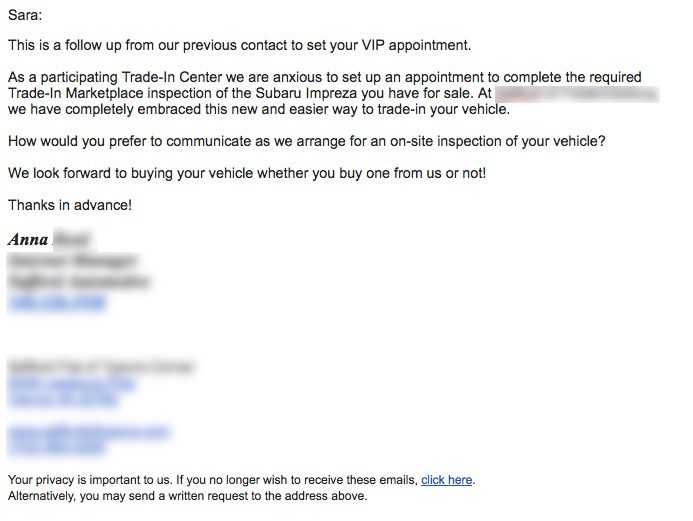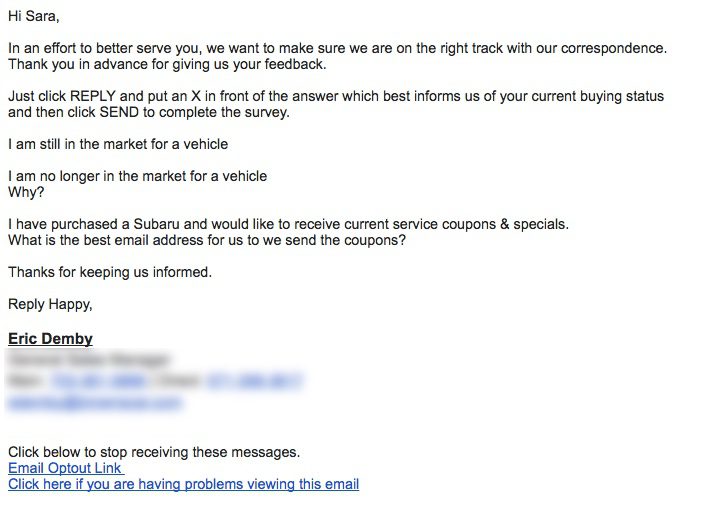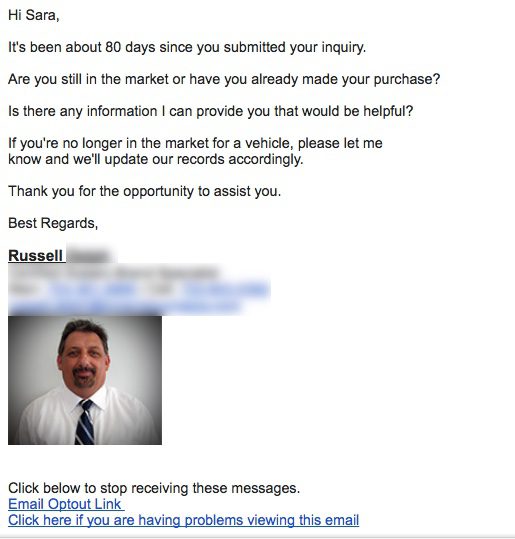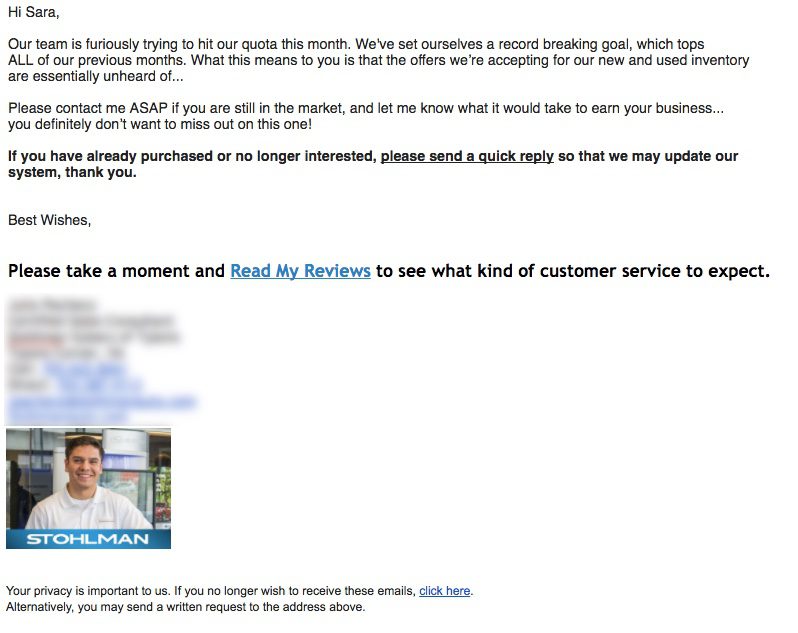 Ever wondered how to send a follow up email (or three) without potentially annoying the person on the other end? We’ve all been on the receiving side of overly aggressive, sales-y emails. How do you strike the balance between savvy sales technique and overbearing email machine?
Ever wondered how to send a follow up email (or three) without potentially annoying the person on the other end? We’ve all been on the receiving side of overly aggressive, sales-y emails. How do you strike the balance between savvy sales technique and overbearing email machine?
In this article, we’re going to break it down for you.
Learn From the Best
You know who’s great at sending follow up email? Car dealerships. This should come as no surprise, especially if you’ve ever set foot on a dealership lot.
The minute you reach out online to inquire about a car, you’re marked as a lead. Good car dealerships know the value of a good email marketing strategy. They use it to follow up on leads, create and build relationships, and close deals. And you might be surprised to learn that the ones who do it right aren’t too pushy at all.
We know because we recently priced out a new car. Inquiry emails came in immediately, and currently there are at least five separate dealerships that continue to follow up.
They’re on the right track to gauge our level of interest, promote their inventory, and help us make a buying decision.
Take a look at this email:

Russell definitely kept it friendly and included reminders about all the great benefits that come with buying a car from them.
It’s encouraging when a representative reaches out and is genuinely interested in building a relationship and providing good service.
Most correspondence has been pleasant, but we can also confirm that some have gone into the “sending too often” zone. Repetitive, daily emails? No thanks. Thankfully, per the legal requirement, the ones we’ve opted out of have honored that request.
The Breakdown
Auto industry aside, there’s a delicate balance to finding the right time and techniques for successful email follow-ups.
Start with qualifying leads. If you find yourself with a ton of potential leads, none at all, or are in a cloud of uncertainty, start with our sales pipeline guide.
Once you’ve got a list of leads to follow up with, read on.
Now that you know your target customer, here are the best practices for email marketing follow-ups:
1. Get permission to follow up first
The CAN-SPAM act protects consumers from illegal and unwanted emails. Starting by getting permission to email recipients reduces your chances of winding up in SPAM folders. This establishes the relationship and confirms that the interaction is mutual. Think of it like a first handshake with direct eye contact.
CAN SPAM requires that all commercial emails must provide recipients with a way to opt-out of receiving future email messages. Make sure you always include an opt-out link as well as your business contact info (Robly automatically includes all of this in the footer of all your emails).
Getting permission to follow up with leads naturally improves the chances that your emails will get opened. Leads are more likely to be receptive when they are already aware of your intention to contact them via email. It fosters trust in the relationship.
2. Find the right day and time to send
This little nugget can go a long way.
- Experiment with different send times and days to see when you get your best open and/or click rates.
- Be considerate of the time frame during which your leads may take before opening.
- Try to send your follow up emails at a time readers are more likely to be available to read and respond to your message (Friday at 5pm? Probably not the best).
Most email marketing services show engagement stats like opens and clicks so you can analyze the data to determine the best send times. It’s best to wait at least 48 to 72 hours before digging into those numbers though – they can shift quite substantially over that time period.
In Robly, our patent-pending AI tool can target the exact moment your subscriber is most likely to check their inbox by aggregating and analyzing open times for each one of your contacts.
If you’re not using an email service provider, Tuesday, Wednesday, and Thursday are the best target days to maximize open rates as suggested by several different studies.
First Follow Up Email
Well-timed follow ups are also essential for lead nurture. For an initial follow-up email it’s best to respond within 24 hours of the initial interaction.
The first follow-up for a new lead should predict and address needs, ask questions to gauge the level of interest, and focus on building the relationship.
For example, the trade-in follow up below asked us if we preferred to continue using email to communicate.
This is a great question to ask if you’re not sure because it shows deference to the customer’s needs and preferences:

Additional Follow Up Emails
If the first follow up email doesn’t get a response, it’s okay to try again. However, to avoid being too pushy, make sure you wait at least 48 hours – and up to a week – before reaching out again. The car dealerships we liked checked back in about once a week for the first month.
The number of times you attempt to engage a customer who’s not responding (but hasn’t opted out) is up to you, but after five or so attempts it’s safe to call it a cold lead.
After about two months, a few dealerships checked in with us to see if we were still interested, continued to put effort into promoting a good relationship, and made it easy to let them know if we were still interested.
Personally, we loved the “X marks the spot” feedback request seen here:

The most recent follow up was this one, 80 days later. Simple, straightforward, unobtrusive:

Pro tip: Don’t delete or abandon your cold leads. Save them for later. Don’t waste time and energy on them when you could be fostering good quality relationships, but keep them in the loop.
If you have their permission already, add them to your newsletter that might spark their interest for something later. This is also something the dealership excelled at.
3. Details, details, details
This is a small but necessary component of the follow up. A 2017 Return Path report showed that only 80% of email is properly delivered and received.
Avoid unnecessary, additional follow ups by getting email addresses right the first time and keep your data up to date. If you’re not using an email service make sure you have an organized system for categorizing and maintaining up to date contacts.
Beyond spelling mistakes, make note of anything unique or interesting about your leads – such as where they’re from, interests, and hobbies. These provide excellent ways to naturally connect with someone, which leads to our next tip…
4. Focus on the relationship
Make it as easy as possible for your recipient to have a relationship with your product or service. Know as much as possible about your customer base, and make an effort to solve their issues.
Each of the steps we already talked about play into that, but that’s not always enough. While email marketing is digital and doesn’t require face-to-face interaction, people can tell when intentions are insincere or overly aggressive.
Many people also follow the better-safe-than-sorry rule. That means the more doubt your recipients have about your intentions, the greater the chance they will delete your email and forget all about you.
They need to know you have a genuine desire to meet their needs. You’re not being pushy if you’re trying to connect and assist as opposed to focusing only on the hard sell.
Like we mentioned above, it’s great when you can connect with someone on a non-sales level. Maybe you’re from the same town or have a mutual interest in underwater basket weaving – these types of connections can help to remove any perceived buying pressure the prospect may feel.
5. Use data
There are two types of data you can use to nurture your customer relationship: analytical and qualitative data.
Analytical Data
Use analytical data to understand when and how you can connect with your customers. Analytical data includes information like email open rates, popular open times, click through rates, and response rates.
Analytical data help to narrow down the best time to send. This type of data can also offer insight into how long your emails should be, which videos are watched, and what links are clicked most.
For example, if shorter emails get more engagement, keep them short! If your emails with embedded videos get more click-throughs, then include videos regularly.
This type of data also shows how your customers access your emails. Experian data from 2015 showed that email usage on mobile increased consistently over the years, up to 54%. With a continually growing mobile market it’s safe to assume that mobile use has increased since then. It’s pretty clear that use of mobile optimized templates really is a must (all of Robly’s templates are mobile responsive).
While it’s easy to find stats online for “typical” open and click rates, you’re better off tracking your own opens, clicks, and other patterns. As a result, you’ll gain valuable insight into your own customers’ specific habits and preferences. Then, you can build marketing plans around them.
Qualitative data
Qualitative data is information about qualities — it reflects people and personalities more than statistics. It’s information that can’t actually be measured with numbers and statistics. You can gather qualitative data by looking at engagement.
It’s more intuitive data that helps you get to know your customers on a personal level. This type of information to formulate your marketing angles is what will help make your product or service a “must-have” in the eyes of your customer.
For example, a car dealership trying to upsell a premium model might learn that an interested prospect has kids and wants safety features.
That information would undoubtedly be leveraged into a compelling pitch: The premium model will stop if it sees an obstacle, has an extra folding back seat, will alert you when another vehicle is in your blind spot, and has a backup camera.
With that qualitative data, (ie, has kids and values safety), it’s more likely that a sale will be made, because the entire pitch can be morphed around the buyer’s needs.
Though fully digital, email marketing is still a person-to-person experience. The point is to use all this data to collect as much information as you can in order to predict what your prospects need and want to know.
How to Get More Data
Need more qualitative data? Ask for it – your first follow up email is a great place to do this.
The fastest way to do this is to include questions in your lead gathering techniques.
Going back to the car dealership as an example, they will know what make and model you’re looking for, but they may ask what extra features you’re interested in, where you live, your price range, if you’re going to trade in, and/or how quickly you want to buy.
You can include surveys or polls to collect this type of data. Ask why they’re interested, how your product or service can help them, and what information they need to make the commitment to move forward.
This all provides an opportunity to learn from and educate the buyer.
When you take the time to connect with your customers, they won’t feel pressured or pushed to buy.
Instead of seeing a product or service and what it will cost them, you’ll allow them to see a valuable product or service that can improve their life.
6. Personalize and perfect your follow up
Now you’re ready to send that first follow up email. You have permission to send. You know the right day and time to hit your customers and all about what they want and need.
Now it’s time to put a bow on it.
- Personalize the subject line. In 2014, Experian reported that personalized emails are six times more likely to be opened and get a response. SPAM filters tend to catch generic subjects that are overused, so avoid cliché and repetitive phrases, and include the recipient’s name when you can. Hubspot has a great list of words you should avoid in emails and subject lines.
- Make sure to include a permission reminder – it should be clear, concise, and provable. Robly adds this to your footer automatically, but it’s never a bad idea to put it at the top of your email, too.
- Reference specific, previous purchases or interactions to tie in your product or service if you can. For example, Amazon sends emails for what they believe you’d want based on your previous shopping habits.
- Make it personal, tie in emotional or moral values, and offer a clear solution. According to Psychology Today, emotions compel people to action, and positive emotions associated with a brand support customer loyalty. You can utilize emotions a few different ways:
◦ Define a personal or social issue that you believe your product or service can address.
◦ Encourage a sense of urgency for the customer like our car dealership did by offering them a great deal and requesting their help meeting a deadline: ◦ Reinforce the positive feel good emotions associated with the solution with testimonials or reviews.
◦ Reinforce the positive feel good emotions associated with the solution with testimonials or reviews. - Offer a free takeaway. This can strengthen the relationship and the effectiveness of your product or service. However, make sure whatever you are giving away has value – otherwise, it may come across as cheap or manipulative.
- Segment your lists into different demographic groups. You can filter by company, gender, interests, location, or really any number of areas that your product or service can relate to. Segmentation provides more value and personalization to the recipients you target. As long as you collect the information and store it, you can use it to segment.
- Include links and easy access to your support channels and social media. Make it easy for your customers to engage. If you give them a sense of urgency or need to buy, make it easy to act right away. Link to your products and services straight from your email. Link to those social media channels and provide contact information.
- Use a professional but personal signature. Include your contact info and consider adding a picture. It will reinforce the idea that they are dealing with a person who can empathize and help solve issues, not just a business looking for money.
At the end of the day, we buy more from people we like, so if you want to send a good follow up email without being too pushy, be like our favorite car salesman Russell. Find out what your customers need and value. Then, instead of pushing your need to sell, show them what they have to gain by buying.
-Sara Sorola


